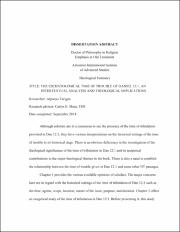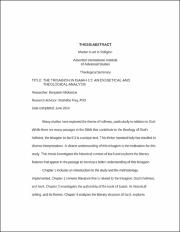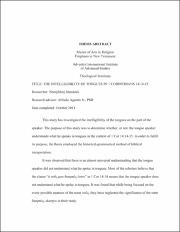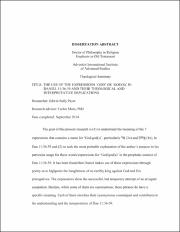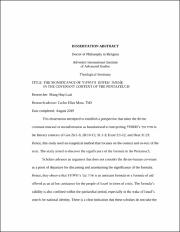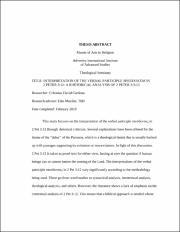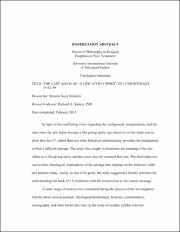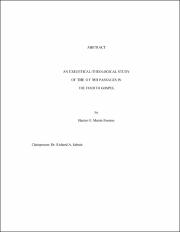Search
Now showing items 21-30 of 48
The Eschatological time of trouble of Daniel 12:1 : an intertextual analysis and theological implications
(Adventist International Institute of Advanced Studies, 2014-09)
Although scholars are in a consensus to see the presence of the time of tribulation
provided in Dan 12:1, they have various interpretations on the historical settings of the time
of trouble in its historical stage. There ...
The Trisagion in Isaiah 6:3 : a theological and exegetical study
(Adventist International Institute of Advanced Studies, 2014-06)
Many studies have explored the theme of holiness, particularly in relation to God.
While there are many passages in the Bible that contribute to the theology of God's holiness, the trisagion in Isa 6:3 is a unique text. ...
The Intelligibility of tongues in 1 Corinthians 14:14-15
(Adventist International Institute of Advanced Studies, 2014-10)
This study has investigated the intelligibility of the tongues on the part of the
speaker. The purpose of this study was to determine whether, or not, the tongue speaker
understands what he speaks in tongues in the context ...
The Use of the expressions God or God(s) in Daniel 11:36-39 and their theological and interpretative implications
(Adventist International Institute of Advanced Studies, 2014-09)
The goal of this present research is (1) to understand the meaning of the 7
expressions that contains a name for ‘God/god(s)’, particularly 3) אֵל x) and 4) אֱלוֹהַּ x), in
Dan 11:36-39 and (2) to seek the most probable ...
The Significance of YHWH's EHYEH IMMAK in the covenant context of the Pentateuch
(Adventist International Institute of Advanced Studies, 2019-08)
This dissertation attempted to establish a perspective that takes the divine covenant renewal or reconfirmation as foundational to interpreting YHWH’s אהיה עמך in the literary contexts of Gen 26:1-6; 28:10-15; 31:1-3; Exod ...
Interpretation of the verbal participle Speudontas in 2 Peter 3:12 : a rhetorical analysis of 2 Peter 3:3-13
(Adventist International Institute of Advanced Studies, 2018-03)
This study focuses on the interpretation of the verbal participle σπεύδοντας in 2 Pet 3:12 through rhetorical criticism. Several explanations have been offered for the theme of the “delay” of the Parousia, which is a ...
Armageddon as divine war in the Apocalypse
(Adventist International Institute of Advanced Studies, 2011-05)
The word "Armageddon" appears only once in the
whole Bible as the name of the site for the eschatological
battle on the great day of God the Almighty (Rev 16:16).
Though it appears only once in the Bible, it has been ...
The Last Adam as "a life-giving spirit" in 1 Corinthians 15:42-49
(Adventist International Institute of Advanced Studies, 2015-02)
In light of the conflicting views regarding the background, interpretation, and the
time when the last Adam became a life-giving spirit, one objective of this study was to
show that the OT, rather than any other historical ...
A Study of the Hebrew and Aramaic clauses alluding to temple defilement in Daniel
(Adventist International Institute of Advanced Studies, 2020-12)
This dissertation is a study undertaken to explore 44 selected Hebrew and
Aramaic clauses that allude to temple defilement in the book of Daniel. Chapter 1 is
introductory. Chapter 2 is focused on the exegesis of the ...
An exegetical-theological study of the OY MH passages in the fourth gospel
(Adventist International Institute of Advanced Studies, 2012-02)
Although grammarians have noted the phenomenon of the emphatic denial ouj mh; (ED) in the Fourth Gospel, a survey of the standard critical commentaries on the Gospel of John reveals that there is scanty work about its ...

